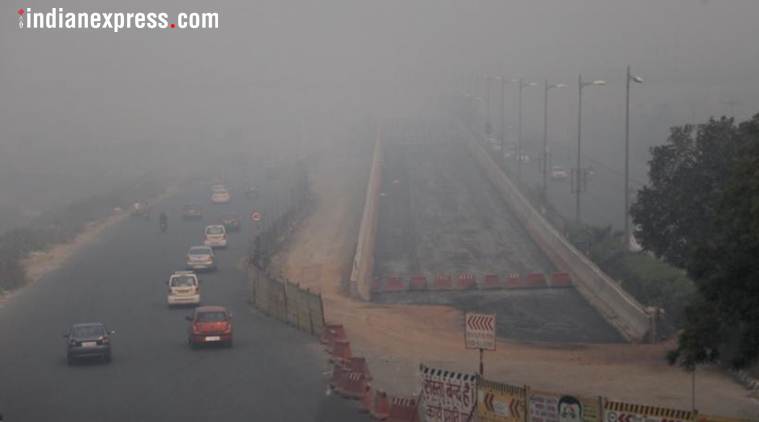A passage to clean air
Delhi needs an ‘Air Quality Manager’ with clearly defined powers and mandate

To win the battle against air pollution, India needs a comprehensive action plan for the whole year. (Express Photo by Abhinav Saha)
Globally, rapid economic and social development has resulted in severe air pollution that kills around 7 million people every year, and India is home to 14 of the world’s 20 most polluted cities. Diwali has just passed and “Parali” is ongoing, along with accompanying murmurs and hints of action to ameliorate the air quality situation in Delhi. However, to win the battle against air pollution, India needs a comprehensive action plan for the whole year.
It is noteworthy that China had also faced severe air pollution problems. On January 12, 2013, the Air Quality Index (AQI) in Beijing rose to a record 755. It was “Beyond index” on a scale where the worst level and concentration of PM2.5 reached 886 µg/m³, about 35 times the guideline set by the World Health Organisation on what is called the “Blackest Day”. In response, China acted firmly: On March 17, 2013, Premier Li Keqiang announced: “We need to face the situation and punish offenders with no mercy and enforce the law with an iron fist”. In September 2013, the Chinese government announced an Air Pollution Action Plan with a PM 2.5 reduction target of 33 per cent in Beijing by 2017, with 2013 as the base year. The measures adopted were costly, controversial and implemented with seriousness, enabling the city to achieve its target.
Along similar lines, in 2017, the South Korean government also set a target of PM 2.5 reduction by 30 per cent by 2022, with base year 2017. What enabled China, and gives hope to South Korea, to realise their targets? Based on their experience, and other insights, we feel that India needs three action measures to begin its journey towards clean air.
The first is a comprehensive plan and setting of goals. Common sense as well as the international experience recounted above point to the importance of setting goals for any major achievement. On this count, moving on the right track, the Indian government on May 17 had announced a draft of the “National Clean Air Programme (NCAP)” with a framework and multiple strategies to reduce air pollution in the entire country. There was some criticism then for not setting up any goals or schedule to reduce air pollution. Responding to the same on November 1 this year, the government finally announced time-bound air pollution reduction targets at the first global conference on air pollution and health in Geneva. According to the announcement, the Ministry of Environment, Forest and Climate Change (MoEF) has set a target to cut down PM levels by 30 per cent in five years, with 2019 as the base year.
The second corresponds to another perennial insight from all major programmes and projects: Designating an in-charge, empowered with the due mandate. While Delhi does have the Graded Response Action Plan (GRAP), statutory notifications, court orders and several other measures in place, the multiplicity of the agencies involved makes the implementation everybody’s burden and nobody’s mandate. Therefore, with air quality goals clearly in place, Delhi now needs an “Air Quality Manager” with a clearly defined mandate and powers. This need is so obvious that it is conspicuous by its absence.
International experience corroborates this and shows the way. In China, air pollution prevention and control is the responsibility of the central environmental protection inspector, and in cities where air pollution prevention and control work is ineffective, special inspections are carried out to strengthen the accountability of inspectors. The Ministry of Ecology and Environment publicly interviews the key personnel of the local government and could cancel the honorary title of ecological civilisation granted by the state. The main leaders of the local governments are the first responsible persons in their administrative regions for the implementation of their pollution reduction plan in a powerful and orderly manner. To top it all, the Chinese government has established the “five-step” supervision mechanism that involves investigation, assignment, verification, interview and special inspection. They have also proposed a “double random, open method”.
Our last action item is about driving a change in perspective. A view often touted about pollution reduction plans is that they are economically and politically difficult. However, clean air programmes can actually provide significant economic opportunity in areas of technology, business, innovation, and enterprise while addressing the challenges of air pollution. Some evidence for this already exists, and some steps have already been taken. For instance, both India and China are focusing on renewable energy sources (especially solar photovoltaic) to reduce the air pollution problem.
Further, according to the NITI Aayog report on “Zero Emission Vehicles (ZEVs): Towards a Policy Framework”, electric vehicles could launch new business opportunities in areas such as battery charging and swapping infrastructure, service, or integrated transport. The Bluetech Clean Air Alliance (China) estimates that “By 2030, China’s key areas of clean air will usher in more than 20 trillion RMB (around 3.2 trillion US dollar) market opportunities, and China will continue to be the world’s largest demand market for clean air technology (BCAA shared China’s experience of fighting air pollution with India, 2018)”. There are several other studies globally that suggest an overall positive impact on the GDP, society and political economy upon introduction of EVs in fuel importing service dominated economies.
One study has estimated that driving the shift to electric vehicles would lead to a 1 per cent increase in the EU GDP. In another study, net private and social benefits are estimated between $300 and $400 per EV. The European Climate Foundation has estimated that through reducing oil demand by more efficient electric cars, employment will increase by 5,00,000 to 8,50,000 by 2030. Another report estimates that about 2 million additional jobs will be created through EVs by 2050 (Juyal et al., 2018). In the Indian context, coupled with the generation of renewable power, the battery manufacturing industry in India can become bigger than the total amount spent on import of crude oil, thus providing a huge boost to the Indian economy. Even the loss in tax revenue corresponding to the oil sector can be potentially compensated by the tax revenue from other economic sectors.
So clean air, apart from better health and quality of life, can also bring in higher GDP, more jobs, more business, social benefits and higher tax revenues. It certainly doesn’t look like an economically or politically difficult proposition. Who can complete this picture, though, and take it to the masses? Perhaps, a visionary leader and statesman.
Khare and Bolia are faculty members at IIT Delhi, and coordinator and co-coordinator of its Centre of Excellence for Research on Clean Air (CERCA)






































No hay comentarios:
Publicar un comentario